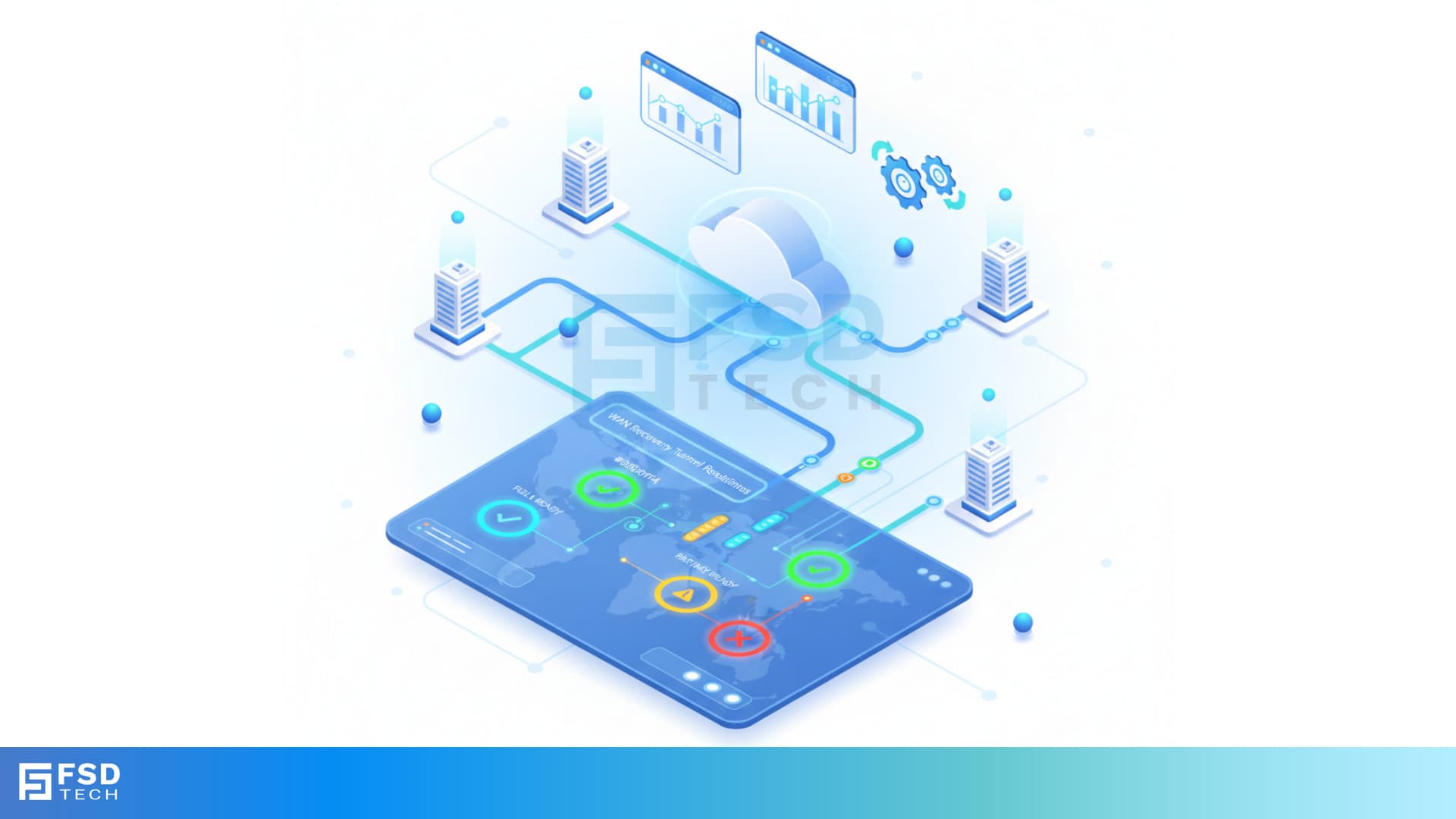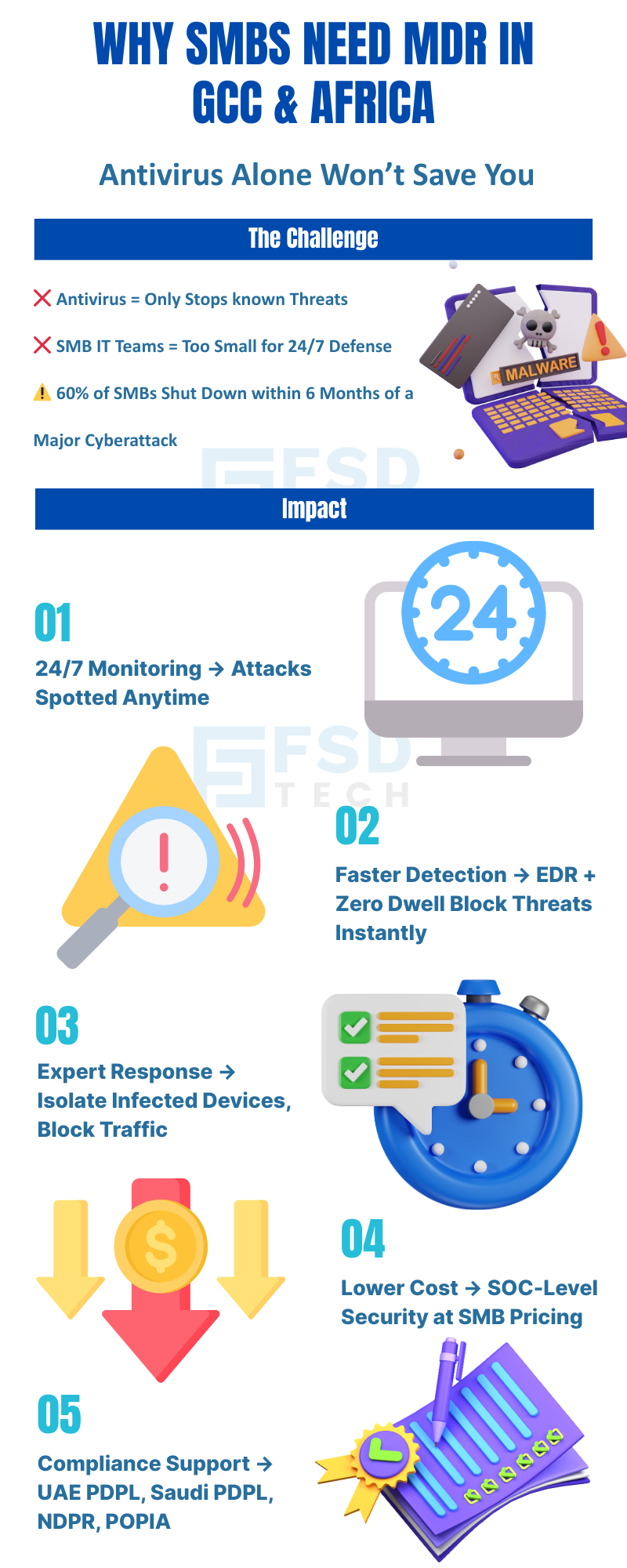
WAN Recovery Tunnel Status in Cato SASE: Readiness You Can See
🕓 September 30, 2025

Imagine you’re the CEO of a growing logistics company in Dubai. Business is booming — your trucks move goods daily across UAE and Saudi Arabia. But one morning, your IT team calls you:
“Sir, we think something strange is happening. Files are moving on their own. Systems are slowing down. We’re not sure if it’s an attack.”
You immediately ask: “But don’t we have antivirus?”
Yes, you do. But here’s the catch: today’s cybercriminals are smarter, faster, and far more creative than what antivirus can handle.
Antivirus is like a security guard who only recognizes criminals he has seen before. If a thief shows up in a new disguise, he walks right past.
For SMBs and mid-market firms in GCC & Africa, this gap is dangerous. You may not have a large in-house cybersecurity team, yet the threats you face are just as advanced as those targeting big enterprises.
So, what’s the solution?
That’s where MDR (Managed Detection & Response) comes in — your own 24/7 cyber defense team, but without the cost of building one from scratch.
MDR stands for Managed Detection & Response.
Think of it as “Cybersecurity-as-a-Service.”
It combines:
Instead of relying on your small IT team (or a single “IT guy”) to fight off cyberattacks, MDR gives you access to a fully equipped Security Operations Center (SOC) — but delivered as a subscription service by providers like FSD-Tech.
Analogy: It’s like having a fire alarm system (technology) plus a trained fire brigade (human experts) always ready to jump in. Alone, the alarm isn’t enough. But when combined with professionals who know exactly how to handle a blaze, your business is truly safe.
Many SMB leaders ask: “But don’t firewalls and antivirus protect us already?”
Here’s the difference:
Key Point: With MDR, you don’t just receive an alert that “something suspicious happened.” You have experts fixing the problem immediately.
SMBs in Dubai, Riyadh, Nairobi, Lagos, and Johannesburg face the same advanced cyber threats as global enterprises — but often with:
This makes SMBs a prime target for hackers who know you’re less protected but still handle valuable data: customer records, payments, intellectual property, contracts.
Fact: A recent global study found that 60% of SMBs shut down within six months of a major cyberattack.
Cybercriminals don’t work 9–5. Many attacks hit at night or during weekends when your staff isn’t watching. MDR ensures constant monitoring — every hour, every day.
MDR uses advanced tools like EDR (Endpoint Detection & Response) and Zero Dwell Containment to detect threats before they cause damage.
Example: If an employee unknowingly clicks a malicious link at 2 a.m., MDR systems detect the unusual activity instantly and block it — instead of waiting for Monday morning.
Instead of leaving your IT staff panicking over a suspicious alert, MDR brings in trained analysts who can:
It’s like having a cyber “SWAT team” on standby.
Building your own 24/7 SOC can cost hundreds of thousands of dollars per year. MDR gives you the same capability for a fraction of that cost.
With regional regulations tightening, SMBs must prove they can secure customer data. MDR helps maintain compliance with:
This not only avoids fines but also builds customer trust.
To keep it simple, here’s how MDR protects your business:
Every device, server, and network connection is continuously monitored.
AI-powered tools and threat intelligence spot suspicious activity.
Human analysts review alerts to confirm whether it’s a real threat or a false alarm.
If it’s real, action is taken instantly: the infected device is isolated, malicious files are removed, and threats are neutralized.
You get clear reports that explain what happened and how it was resolved — in business language, not tech jargon.
Visual Flow: Monitor → Detect → Investigate → Respond → Report
A mid-sized law firm in Nairobi received a phishing email disguised as a client document. An employee clicked and unknowingly launched malicious code.
Outcome: No data loss, no downtime, no client impact.
See How MDR Works for Companies Like Yours Click Here
MDR and Zero Dwell Containment are a perfect pair.
Together, they:
It’s like having both a strong lock on your door and a guard who responds instantly if someone tries to break in.
Here’s what many SMB leaders don’t realize:
Key Takeaway: Prevention costs are predictable and affordable. Recovery costs are unpredictable and catastrophic.
At FSD-Tech, we deliver MDR powered by Xcitium’s global technology and supported by our 24/7 Security Operations Center.
Whether you’re a mid-sized hospital in Riyadh, a retail chain in Nairobi, or a logistics provider in Lagos — we tailor MDR to your business needs and budget.
Cyberattacks don’t wait for office hours. They strike when you least expect — and without MDR, your defenses may already be breached before you know it.
For SMBs and mid-market businesses in GCC & Africa, the choice is clear:
The smarter move? Act now. Because in cybersecurity, waiting often means paying more — in money, reputation, and lost trust.
With MDR from FSD-Tech, you’re not just buying a service. You’re buying peace of mind.
Ready to strengthen your cyber defenses? Book your expert consultation today.

MDR stands for Managed Detection & Response.
It means a team of security experts, working for you 24/7, watching your computers, servers, and networks for any sign of danger — and stopping threats before they cause damage.
Antivirus is like a security guard who only recognizes criminals they’ve seen before.
MDR is like a whole team of guards who:
Yes. A firewall controls who can enter or leave your network, but it can’t catch everything — especially new, unknown threats.
MDR works inside your systems to catch threats that sneak past the firewall.
MDR is for any business that:
MDR has two parts:
MDR can respond in minutes or even seconds, depending on the type of threat.
This is much faster than waiting for your internal IT team to notice and fix the problem.
Not compared to the cost of an attack.
Building your own security team and systems can cost hundreds of thousands of dollars. MDR gives you the same level of protection for a low monthly cost.
Yes — MDR works alongside your firewalls, antivirus, and other tools.
It adds an extra layer of intelligence and human monitoring on top of them.
No. The monitoring happens in the background without affecting the speed of your computers or networks.
Yes — MDR covers devices no matter where they are, whether in your office, at home, or traveling.
In regions like GCC & Africa, laws require businesses to protect customer data.
MDR helps you meet these requirements by:

Anas is an Expert in Network and Security Infrastructure, With over seven years of industry experience, holding certifications Including CCIE- Enterprise, PCNSE, Cato SASE Expert, and Atera Certified Master. Anas provides his valuable insights and expertise to readers.
Share it with friends!

🕓 September 30, 2025
.jpg&w=3840&q=75)
🕓 September 29, 2025

🕓 September 27, 2025
share your thoughts